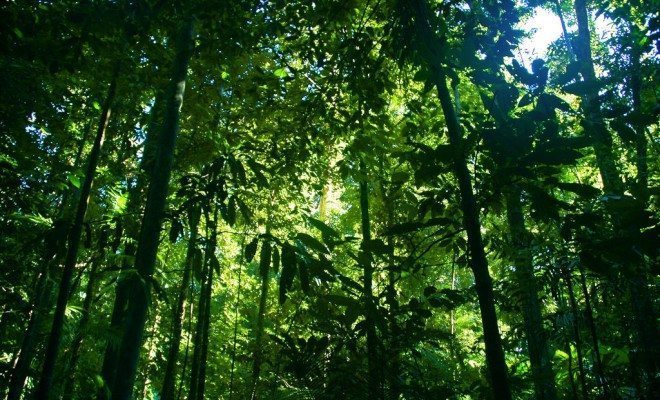 Image courtesy of [ben britten via Flickr]
Image courtesy of [ben britten via Flickr]
Energy and Environment
Why Protecting Forests and Animals Should Be the Same Mission
Images of deforestation are among the most striking when it comes to addressing human impact on the environment and all the problems that follow. Similarly, endangered animals are constantly in the conversation and the need to enact more protections and conservation measures remains pressing.
Read More: Endangered Species Protections: Are We Doing Enough?
Yet what tends to be overlooked is that from both an ecological and human policy-related standpoint these things are deeply interrelated. When we consider how to protect and improve our forests and our biodiversity, we should think about them in tandem.
Among the innumerable reasons why maintaining forests is important, one is that they store carbon. Having it naturally contained in the biomass means that there is less in the atmosphere; forests help keep greenhouse gases and climate change in check. But, as has been a topic of conversation for decades now, some of the most substantial ones, such as the Amazon Rainforest, are in danger. A 30-year study by the University of Leeds concluded that the unnaturally large amount of carbon in the atmosphere has accelerated the lifespans of trees there. This means that they die younger; high tree mortality is an unexpected contributor to the shrinking of the rainforest. It is not just a matter of logging and increased building. With a higher tree mortality and a decreasing range of the forest, the amount of carbon the rainforest can store has been overtaken by the amount of fossil fuel emissions in Latin America.

Courtesy of CIFOR via Flickr.
Another consequence of deforestation is the loss of biodiversity that resides therein. It has been determined that there exists a “threshold” for forest cover, and if it is surpassed then the loss of species accelerates in quantity and geographic spread. Most surveys tracking deforesting activity indicate that thresholds are drawing quite near or have recently been surpassed. The problem with the way this issue is approached is that Brazilian law applies activity to individual farms and their property. Rather, due to the more complex nature of animal geographies and forest topography, policies need to take into account particular regions in the rainforest.
This concept is further complicated by the interrelatedness of forests and animals. It is not just a matter of aesthetically preserving animals, but they play an integral role in the health of the forest itself. Similar to how bees have a key function in floral reproduction because they distribute pollen from plant to plant, large animals spread around tree seeds as they go about their business. Big mammals in particular tend to have a wide range, traveling far in search of food and marking their territory. As forests and animals affect each other reciprocally, damaging one invariably damages the other, which in turn degenerates the other further and onward in the vicious cycle. This is another series of reasons why the New Jersey bear hunt ought to be rethought.

Courtesy of laurence_baulch via Flickr.
These problems are not restricted to the Amazon and Latin America. The national park system in the United States is primarily designed to preserve scenic natural wonders. Yet a new study demonstrates that the locations of these parks do not line up with the general locations of biodiversity in the country that are in need of protection. The bulk of parks is concentrated in the American West, where the lands are relatively sparsely inhabited compared to the East, South, and Appalachians, which contain many “unique or rare species” whose interests are not properly addressed. It is in these geographic regions, researchers explain, that the majority of the continent’s endemic species are located. Meaning that they are not found elsewhere in the world or in other habitats, endemic species play an vital role in the health and operations of their ecosystems. Once more, if they become too severely threatened and begin to die out then the surrounding forests and general environments themselves, and subsequently human health, are likely to degrade substantially.
In addition to striving to protect the correct and most vulnerable areas, there are generally speaking two measures we can take in order to avert crises. The first is to pursue development in a more conservation-oriented fashion. Laying down specific ground rules when pursuing building projects, especially roadways and infrastructure, can help decrease the amount of destruction that follows. This way, as representatives of the plan have put it, “We’re not anti-development, we’re anti-environmentally destructive development.” The second course of action is to actively attempt to restore forest cover. Leading the way in this endeavor is China, whose Three-North Shelter Forest Program is creating a corridor of trees intended to diminish expansion of the Gobi Desert. Reducing desertification will also ensure there is more farmable land, which is obviously in human interest as well.
We have been talking for a very long time about saving the trees and preserving the rainforest. But there is a lot more at stake than symbolic environmentalism or ensuring there is enough oxygen to breathe. Carbon storage, wildlife habitats, anti-erosion, anti-desertification, and many other things on a long list are at stake. Addressing these concerns, while also thinking about the status of many animals, will help to improve the condition of both as well as the many interrelated factors on the Earth.








Comments